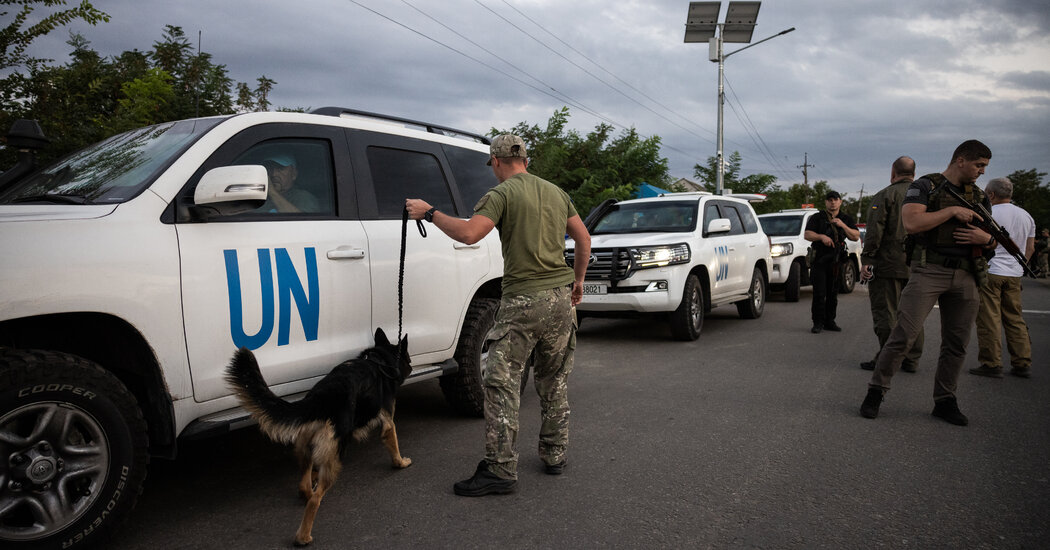Renewed Shelling Puts Nuclear Plant at Risk Despite U.N. Presence

Even as hopes were raised that a permanent presence of United Nations inspectors would help reduce the risk of disaster at the Zaporizhzhia nuclear power plant in Ukraine, the war once again endangered the plant’s safe operation.
After shelling on Friday evening, the plant lost the connection with its only remaining primary external power line, forcing it to use a lower-voltage reserve line to power the cooling equipment needed to prevent meltdowns, the International Atomic Energy Agency said in statement on Saturday.
Still, the director of the agency, Rafael Mariano Grossi, expressed cautious optimism that a plan to station two nuclear experts at the plant indefinitely would help lower the risk of a catastrophe.
“We believe it was important for the agency to be there permanently,” he said. “The difference between being there and not being there is like day and night.”
The decision to keep monitors at the plant despite the obvious risks underscored what Mr. Grossi called the “unprecedented” peril of the moment. He added that putting independent nuclear experts at the plant will allow for unbiased reports on conditions in real time.
“Now, when there is an allegation that something has happened at the plant, you can turn to us,” he said, rather than weighing the conflicting claims of Russia and Ukraine.
Mr. Grossi, who has avoided placing blame for the shelling on either the Russians or the Ukrainians, said Friday that it appeared the power supply to the plant was being deliberately targeted.
“It is clear that those who have these military aims know very well that the way to cripple or to do more damage is not to look into the reactors which are enormously sturdy and robust,” he said. Instead, the plant is being hit where it hurts — the power lines essential for running it.
On Saturday, Mr. Grossi said that the presence of the agency’s inspectors, who were able to confirm the damage to the external power line, was already proving valuable.
“Our team on the ground received direct, fast and reliable information about the latest significant development affecting the plant’s external power situation, as well as the operational status of the reactors,” he said.
One of the six reactors at the plant is currently operational, the agency said, and is producing electricity for both cooling and other essential safety functions at the site, and for Ukrainian households and factories.
The U.N. move to keep a pair of inspectors at the plant comes as fighting has continued to rage across southern and eastern Ukraine. The plant lies precariously close to some of the most intense fighting.
Late last month, the Ukrainian military launched a counteroffensive in the south, including the area just across the Dnipro River from the nuclear plant, in the western Kherson region. On Saturday British military intelligence said that Ukraine’s advance on three fronts was likely to have “achieved a degree of tactical surprise; exploiting poor logistics, administration and leadership in the Russian armed forces.”
But military analysts have dampened expectations for the Ukrainian drive, saying that between 15,000 and 25,000 Russian soldiers are stationed in fortified defenses to the west of the Dnipro.
Jack Watling, a research fellow and specialist in land warfare at the Royal United Services Institute in Britain, wrote that unless Russian forces collapse because of abysmal morale — which he said “is possible but not something that can be assumed in planning” — then any battlefield success for the Ukrainians would take time.
In a different front in the Ukraine war, German officials expressed guarded confidence that their country could endure a winter without Russian energy, after Russia postponed gas deliveries to the country indefinitely.
Knowing President Vladimir V. Putin’s history of wielding energy supplies as a foreign policy tool, Berlin has been preparing for months for the possibility that Russia may cut gas deliveries in retaliation for European opposition to Moscow’s invasion of Ukraine.
The German government has imposed tough energy-saving measures, and the ministry overseeing gas deliveries noted that Germany’s gas storage is already nearly 85 percent full, a target set for the beginning of October.
And while Germany was getting 55 percent of its natural gas from Russia in February, when Russia invaded Ukraine, Russian gas accounted for only around 10 percent of Germany’s gas mix on Tuesday — the last full day when gas flowed through the Nord Stream 1 pipeline — thanks to months of sourcing gas from other countries.
Gazprom, the Russian-owned energy giant, had been expected to resume the flow of gas through the Nord Stream 1 pipeline on Saturday after three days of maintenance. But hours before, offering what a European Union official called “fallacious pretenses,” it said that it had found oil leaks around a turbine used to pressurize the pipeline, forcing it to call off the restart. It did not give a timeline for restarting.
In Washington, the Biden administration on Friday asked Congress for $13.7 billion in additional aid for Ukraine, underlining its commitment to support the war-battered country even as the conflict shows little sign of abating.
As part of the Ukraine funding request, $7.2 billion would be used to give new weapons and military equipment to the country, replenish U.S. stockpiles and provide other defense-related support, administration officials said. An additional $4.5 billion would support the Ukrainian government, and $2 billion would be used to offset effects on energy supplies from Russia’s invasion.
Marc Santora reported from Kyiv and Andrew E. Kramer from Zaporizhzhia, Ukraine. Reporting was contributed by Christopher F. Schuetze from Berlin, Michael D. Shear from Washington and Dan Bilefsky from Montreal.
